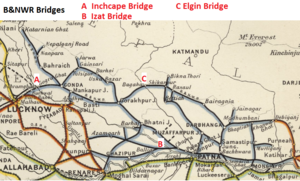Izat Bridge: Difference between revisions
New page all checked |
Map, Photo and extra text added |
||
| Line 1: | Line 1: | ||
[[File:B&NWR Bridges ABC.png|thumb|B&NWR Bridges - '''Izat Bridge''']] Marked '''B''' on map | |||
The '''Izat Bridge''' was completed in July 1912 and opened to traffic on 31 October 1912 <ref>[http://searcharchives.bl.uk/primo_library/libweb/action/search.do?fn=search&ct=search&initialSearch=true&mode=Basic&tab=local&indx=1&dum=true&srt=date&vid=IAMS_VU2&frbg=&vl%28freeText0%29=Izat+Bridge&scp.scps=scope%3A%28BL%29 India Office Records “Photocopies of papers relating to opening of the Izat Bridge built by Bengal and North-Western Railway, and a dinner given by the Company in honour of Alexander Izat” Reference: Mss Eur F379/4]; Retrieved 20 Jul 2016</ref>. | |||
It was constructed by the ‘[[Bengal and North-Western Railway]]’(B&NWR) and spans the Ganges just above its confluence with the Jumna, was sanctioned in January 1909. Well sinking commenced in October 1909 and the bridge was completed in July 1912. It was built under the executive control of Capt. T. Gracey R.E., and named the 'Izat Bridge' by the Board of Directors <ref name=photo> [https://www.bl.uk/catalogues/indiaofficeselect/PhotoEnqFull.asp?PrintID=123274 India Office Records “Bengal and N.W. Ry., Opening of Izat Bridge at Allahabad, on 31st October, 1912”. Photo 1082/13(5)]; Retrieved 20 Jul 2016</ref>. | |||
The bridge was named the 'Izat Bridge' by the B&NWR Board of Directors at the suggestion of Col. Gracey R.E., C.S.I., Chairman of the Company (father of Capt T.Gracey), as a memorial of the value of the services to the Company of Mr Alexander Izat C.I.E. Mr Alexander Izat joined the B&NWR Co. in February 1883 as Agent and Chief Engineer, a post which he held till the 31st May 1904 when he joined the B& | ==Design and Construction== | ||
[[File:Izat Bridge.png|600px|centre|Izat Bridge]] | |||
The Engineers for this bridge were [[Rendel, Palmer and Tritton Partnership |Messrs Rendel and Robertson (now Messrs Rendel, Palmer and Tritton)]]<ref name=Dorman>[https://dormanlongtechnology.com/Download_files/DL%20Historical/Dorman%20Long%20bridges%201930%20book.pdf Dorman Long and Co ‘Bridges’ 1930 Edition)]; Retrieved 26 Nov 2020</ref>. | |||
The steelwork for the Bridge was supplied by Dorman, Long and Co of England <ref>[http://www.gracesguide.co.uk/Dorman,_Long_and_Co Grace’s Guide “Dorman, Long and Co” ]; Retrieved 20 Jul 2016</ref>. The bridge consisted of 40 spans of 150 feet(45.7mtr) clear. The girders are of singular triangulation type, 156 feet between centre of bearings and carry a single line of track of metre gauge ([[Rail_gauge_#Metre_Gauge|MG]]) carried between the lower chords. Each span weighed 124 tons and the total weight of steelwork is therefore nearly 5000 tons<ref name=Dorman/> | |||
==Naming== | |||
The bridge was named the 'Izat Bridge' by the B&NWR Board of Directors at the suggestion of Col. Gracey R.E., C.S.I., Chairman of the Company (father of Capt T.Gracey), as a memorial of the value of the services to the Company of Mr Alexander Izat C.I.E. Mr Alexander Izat joined the B&NWR Co. in February 1883 as Agent and Chief Engineer, a post which he held till the 31st May 1904 when he joined the B&NWR Home Board as Managing Director <ref name=photo/>. | |||
==References== | ==References== | ||
Latest revision as of 11:20, 26 November 2020

Marked B on map
The Izat Bridge was completed in July 1912 and opened to traffic on 31 October 1912 [1].
It was constructed by the ‘Bengal and North-Western Railway’(B&NWR) and spans the Ganges just above its confluence with the Jumna, was sanctioned in January 1909. Well sinking commenced in October 1909 and the bridge was completed in July 1912. It was built under the executive control of Capt. T. Gracey R.E., and named the 'Izat Bridge' by the Board of Directors [2].
Design and Construction

The Engineers for this bridge were Messrs Rendel and Robertson (now Messrs Rendel, Palmer and Tritton)[3].
The steelwork for the Bridge was supplied by Dorman, Long and Co of England [4]. The bridge consisted of 40 spans of 150 feet(45.7mtr) clear. The girders are of singular triangulation type, 156 feet between centre of bearings and carry a single line of track of metre gauge (MG) carried between the lower chords. Each span weighed 124 tons and the total weight of steelwork is therefore nearly 5000 tons[3]
Naming
The bridge was named the 'Izat Bridge' by the B&NWR Board of Directors at the suggestion of Col. Gracey R.E., C.S.I., Chairman of the Company (father of Capt T.Gracey), as a memorial of the value of the services to the Company of Mr Alexander Izat C.I.E. Mr Alexander Izat joined the B&NWR Co. in February 1883 as Agent and Chief Engineer, a post which he held till the 31st May 1904 when he joined the B&NWR Home Board as Managing Director [2].
References
- ↑ India Office Records “Photocopies of papers relating to opening of the Izat Bridge built by Bengal and North-Western Railway, and a dinner given by the Company in honour of Alexander Izat” Reference: Mss Eur F379/4; Retrieved 20 Jul 2016
- ↑ 2.0 2.1 India Office Records “Bengal and N.W. Ry., Opening of Izat Bridge at Allahabad, on 31st October, 1912”. Photo 1082/13(5); Retrieved 20 Jul 2016
- ↑ 3.0 3.1 Dorman Long and Co ‘Bridges’ 1930 Edition); Retrieved 26 Nov 2020
- ↑ Grace’s Guide “Dorman, Long and Co” ; Retrieved 20 Jul 2016